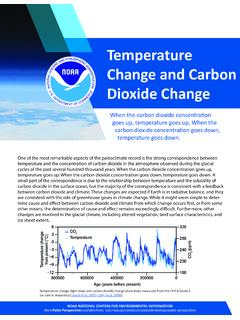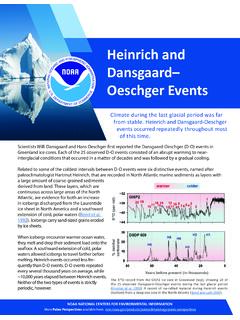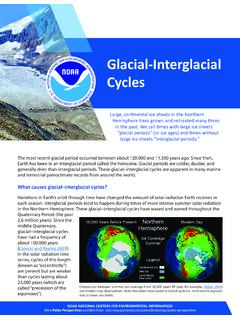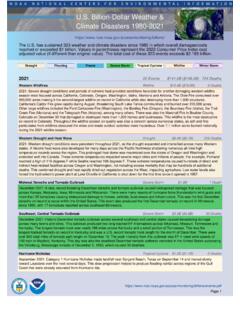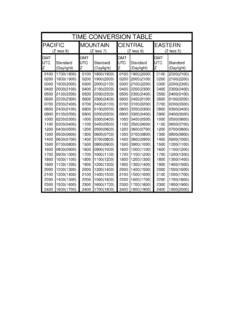Transcription of The Younger Dryas - National Climatic Data Center
1 NOAA National CENTERS FOR ENVIRONMENTAL INFORMATIONThe Younger DryasThe Younger Dryas is one of the most well-known examples of abrupt 14,500 years ago, Earth s climate began to shift from a cold glacial world to a warmer interglacial state. Partway through this transition, temperatures in the Northern Hemisphere suddenly returned to near-glacial conditions. This near-glacial period is called the Younger Dryas , named after a flower ( Dryas octopetala) that grows in cold conditions and that became common in Europe during this time. The end of the Younger Dryas , about 11,500 years ago, was par-ticularly abrupt. In Greenland, temperatures rose 10 C (18 F) in a decade (Alley 2000). Other proxy records, including varved lake sediments in Europe, also display these abrupt shifts (Brauer et al. 2008).The Younger Dryas is clearly observable in paleoclimate records from many parts of the world.
2 In the Cariaco Basin north of Venezuela, for example, temperatures decreased about 3 C ( F), although some of this cooling might have been due to greater upwelling of colder subsurface water (Lea et al. 2003). In many parts of the Northern Hemisphere tropics, conditions also became drier (Hughen et al. 2000; Wang et al. 2001).The story in Antarctica is somewhat different, however. The ice core record at Dome C (See figure on page 2) shows that climate changes in Antarctica were out-of-phase with those in the Northern Hemisphere (EPICA This near-glacial period is called the Younger Dryas , named after a flower ( Dryas octopetala) that grows in cold conditions and that became common in Europe during this Members 2004). At Dome C, the amount of the hydrogen isotope called deuterium, expressed here as D, is proportional to temperature. The deu-terium record indicates that, contrary to the Northern Hemisphere records, temperatures were relatively low prior to the Younger Dryas (a period called the Antarctic Cold Reversal) and rose during the Younger Dryas .
3 This pattern provides an important clue about what caused the Younger Dryas , as will be discussed Paleo Perspectives available here: caused the Younger Dryas ?The Younger Dryas occurred during the transition from the last glacial period into the present interglacial (the Holocene). During this time, the North American, or Laurentide, ice sheet was rapidly melting and adding freshwater to the ocean. Scientists have hypothesized that, just prior to the Younger Dryas , meltwater fluxes were rerouted from the Mississippi River to the St. Lawrence River. Geochemical evidence from ocean sediment cores supports this idea (Carlson et al. 2007), although other possible routings such as to the Mackenzie River cannot be ruled out presently. A more northerly routing of melt-water has a greater impact on the salinity and density of the surface ocean in the North Atlantic, which can cause a slowing of the ocean s thermohaline circulation and climate changes around the world.
4 Multiple proxies for the thermohaline circulation indicate that such changes occurred during the Younger Dryas (McManus et al. 2004; Praetorius et al. 2008; Lynch-Stieglitz et al. 2011). Eventually, as the meltwater flux abated, the thermohaline circulation strengthened again and climate record from Dome C in Antarctica supports this explanation. If the thermohaline circulation were to slow, less heat would be transported from the South Atlantic to the North Atlantic. This would cause the South Atlantic to warm and the North Atlantic to cool. This pattern, sometimes called the bipolar see-saw, is observable when comparing the GISP2 and Dome C records for the Younger Dryas (EPICA Community Members 2004).Climate changes associated with the Younger Dryas , highlighted here by the light blue bar, include (from top to bottom): cooling and decreased snow accumulation in Green-land, cooling in the tropical Cariaco Basin, and warming in Antarctica.
5 Sources: Alley (2000), Lea et al. (2003), EPICA Community Members (2004).Some important datasets related to the Younger Dryas : Alley (2000), temperature and accumulation from the GISP2 ice core, Greenland Hughen et al. (2000), sediment grayscale from core PL07-58PC, Cariaco Basin Lea et al. (2003), sea surface temperature in the Cariaco Basin based on Mg/Ca of forams Wang et al. (2001), 18O data from Hulu Cave in China McManus et al. (2004), sediment geochemistry of core OCE326-GGC5, Bermuda Rise EPICA Community Members (2004), D data from the Dome C ice core, Antarctica Carlson et al. (2007), sediment geochemistry of the St. Lawrence estuary Brauer et al. (2008), sediment geochemistry of Lake Meerfelder Maar, Germany Praetorius et al. (2008), sediment grain size of core ODP984 in the North Atlantic Lynch-Stieglitz et al. (2011), sediment geochemistry from the Florida StraitsThe Younger Dryas occurred during the transition from the last glacial period into the present interglacial (the Holocene).
6 @NOAANCEI and @NOAAS atellites@NOAAData and @NOAAS atellites@NOAANCEIN ovember 2021
